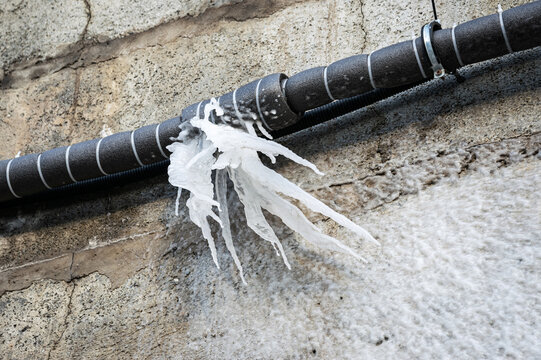Avoiding Frozen Pipes in Cold Weather: Key Tips
Avoiding Frozen Pipes in Cold Weather: Key Tips
Blog Article
Here on the next paragraphs you can discover lots of decent news pertaining to Helpful Tips to Prevent Frozen Pipes this Winter.

Winter can ruin your plumbing, especially by freezing pipes. Right here's just how to stop it from happening and what to do if it does.
Introduction
As temperature levels drop, the danger of frozen pipes rises, potentially leading to pricey repairs and water damages. Comprehending just how to avoid icy pipelines is critical for house owners in cool climates.
Recognizing Frozen Pipelines
What causes pipes to freeze?
Pipes freeze when subjected to temperatures listed below 32 ° F (0 ° C) for prolonged periods. As water inside the pipelines ices up, it expands, taxing the pipe walls and potentially creating them to burst.
Risks and damages
Icy pipelines can bring about supply of water disturbances, home damages, and costly repairs. Burst pipelines can flood homes and create substantial architectural damage.
Indications of Frozen Piping
Determining icy pipelines early can stop them from bursting.
Just how to identify frozen pipelines
Search for lowered water circulation from taps, uncommon odors or noises from pipelines, and noticeable frost on revealed pipelines.
Avoidance Tips
Protecting prone pipelines
Cover pipes in insulation sleeves or utilize warm tape to secure them from freezing temperatures. Concentrate on pipelines in unheated or outside locations of the home.
Heating strategies
Maintain interior spaces sufficiently heated, especially areas with pipes. Open cupboard doors to enable warm air to distribute around pipelines under sinks.
Protecting Outdoor Plumbing
Yard hose pipes and exterior taps
Separate and drain pipes garden pipes prior to winter season. Install frost-proof faucets or cover outside faucets with insulated caps.
What to Do If Your Pipelines Freeze
Immediate activities to take
If you believe frozen pipes, keep faucets open to alleviate stress as the ice thaws. Make use of a hairdryer or towels taken in hot water to thaw pipes gradually.
Long-Term Solutions
Architectural adjustments
Think about rerouting pipelines far from exterior walls or unheated locations. Include additional insulation to attic rooms, cellars, and crawl spaces.
Upgrading insulation
Buy high-grade insulation for pipes, attic rooms, and walls. Proper insulation helps preserve constant temperatures and minimizes the danger of icy pipelines.
Conclusion
Stopping frozen pipelines needs positive procedures and fast responses. By recognizing the causes, signs, and preventive measures, home owners can protect their plumbing throughout winter.
6 Proven Ways to Prevent Frozen Pipes and Protect Your Home
Disconnect and Drain Garden Hoses
Before winter arrives, start by disconnecting your garden hoses and draining any remaining water. Close the shut-off valves that supply outdoor hose bibs and leave the outdoor faucet open to allow any residual water to drain. For extra protection, consider using faucet covers throughout the colder months. It’s also important to drain water from any sprinkler supply lines following the manufacturer’s directions.
Insulate Exposed Pipes
Insulating your pipes is an effective way to prevent freezing. Pipe insulation is readily available at home improvement stores and is relatively inexpensive. Pay close attention to pipes in unheated areas such as the attic, basement, crawl spaces, or garage. Apply foam insulation generously to create a buffer against the cold. You can also wrap your pipes in heat tape or thermostat-controlled heat cables for added warmth.
Seal Air Leaks
Inspect your home for any cracks or openings that could let in cold air. Seal any holes around the piping in interior or exterior walls, as well as the sill plates where your home rests on its foundation. Additionally, make sure to keep your garage door closed unless you’re entering or exiting. Leaving it open creates a significant air leak that can lead to frozen pipes.
Allow Warm Air Circulation
During cold snaps, it’s essential to allow warm air to circulate evenly throughout your home. Leave interior doors ajar to promote better airflow. Open kitchen and bathroom cabinets to help distribute heat consistently around the rooms. If you have small children or pets, be sure to remove any household chemicals or potentially harmful cleaners from open cabinets for safety.
Let Faucets Drip
A small trickle of water can make a big difference in preventing ice formation inside your pipes. When temperatures drop significantly, start a drip of water from all faucets served by exposed pipes. This continuous flow helps prevent the water from freezing. Additionally, running a few faucets slightly can relieve pressure inside the pipes, reducing the chances of a rupture if the water inside does freeze.
https://choateshvac.com/6-proven-ways-to-prevent-frozen-pipes-and-protect-your-home/

I ran across that write up about Prevent Frozen Pipes while doing a lookup on the search engines. Sharing is good. One never knows, you could be helping someone out. I cherish your readership.
Estimate Free Report this page